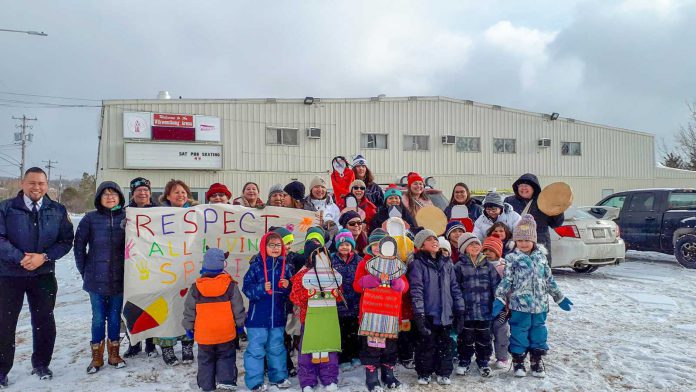
by Michael Erskine
WIIKWEMKOONG—The spirits of attendees of a human trafficking workshop held in Wiikwemkoong on the December 6 National Day of Remembrance and Action on Violence Against Women in Canada were safely enwrapped in the warm sounds of the drum of High Eagle.
Danielle (Roy) MacDonald also performed honour songs during the workshop, including the Snake Medicine Song. “We only pick what we need,” said Ms. MacDonald of the traditional harvesting of medicines and food. “When they hear this song, snakes leave while we are picking our medicines and return after when we are done.”
The day had begun with a walk through the community to bring awareness to Missing and Murdered Indigenous Women and Girls. The walk included workshop attendees, new Wiikwemkoong Police Chief Terry McCaffrey and students from schools in the community.
Human Trafficking Workshop organizer Dorothy Wassegijig-Kennedy noted that crime is called a “new crime, but it has been going for a long time” and that human trafficking takes many forms. She noted that even the residential schools could be considered a kind of human trafficking.
The official definition of human trafficking, she noted, is “a broad term that refers to the exploitation of individuals at the hands of others. Another definition is the recruitment, transportation, harbouring or receipt of persons by means of threat or use of force or other forms of coercion, abduction, fraud, or deception, the abuse of power or of a position of vulnerability, or the giving or receiving of payments or benefits to achieve the consent of a person having control over another person, for the purposes of exploitation.”
“It’s kind of a vague definition,” said Ms. Wassegijig-Kennedy, “but it lets us know everything we need to about human trafficking.”
Ms. Wassegijig-Kennedy noted that the typical victim profile of someone who is trafficked, usually for the sex trade, is “any age, gender and background” and typically “desperate for a better economic future.” The most common victims, she noted, are young girls and boys between the ages of 12 and 25.
“There are many ploys and methods traffickers use to deceive victims, including promises of a better future, marriage, or a good paying job in another country. It is also possible that a victim can be kidnapped from their home country or forced to leave,” she said, adding that victims are “afraid to report it to the authorities.”
Traffickers tend to be mostly men, but there are also many instances where women have been involved, often women who have been victims themselves. “The common name for male traffickers is pimp,” she said. “Pimps are known to lure and recruit their victims, control their earnings through the use of force and threats. They often move and transport their victims and hold them against their will.”
There is even a name that those in the sex trade euphemistically call their tactics. “They call it ‘The Game’,” said Ms. Wassegijig-Kennedy. A key element in The Game is the use of false kindness to manipulate the victim. “They will take a young person to the mall, shower them with gifts, buy them all kinds of stuff without asking for anything in return, at first,” said Ms. Wassegijig-Kennedy. But then comes the moment when the pimp sets the hook. “‘I have done all of this for you, why is it you never do anything for me?’ they will ask,” said Ms. Wassegijig-Kennedy.
Technology, such as the GPS feature of today’s smartphones, can be used to keep track of the victim.
Workshop attendees were shown two YouTube videos that outline an investigation by the Toronto Star entitled ‘Sold Her A Dream’ where a jailed pimp outlined the techniques he used to ensnare vulnerable young women. “It all has to do with love,” he revealed. “You make them believe they have a better future with you.”
A second video from the same investigative journalism effort focussed on the victims. “Everyone just wants to fit in,” said one young victim. But soon they feel trapped, they are trapped, in a nightmare world where their every action is controlled. “He told me what to eat, what to wear, what colour of lipstick to use. He completely controlled my state of mind.”
Getting out is made so much more difficult because of the shame and the judgment they find from the community.
Street worker Allison Recollet Simon noted that is why it is so very important to deal with those trying to break free of human trafficking with kindness and compassion. “They are dealing with trauma, but then find themselves victimized again by a society that blames them for their suffering.” Instead, she said, try to “be understanding, to be kind and to not be judgmental. We have to find it in ourselves to be good to each other. We need to have a softer side.”
Following the workshop presentations, those in attendance took part in a round dance to honour the victims of human trafficking.



